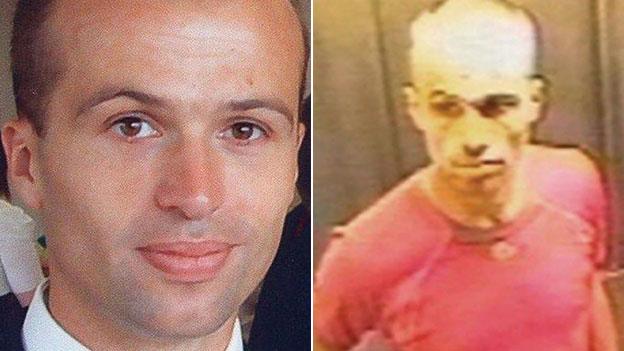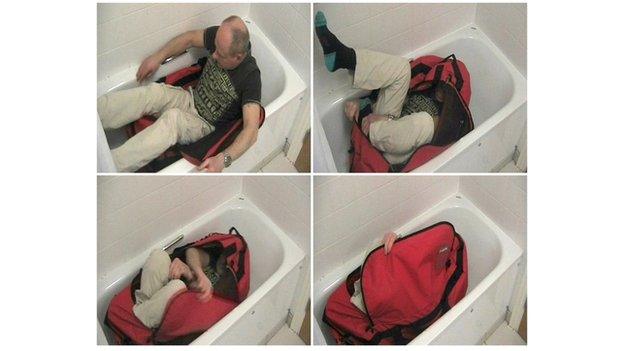MI6 death: Gareth Williams 'probably' killed unlawfully
- Published
Robin Williams, family solicitor: "We are dissapointed at MI6 for failing to make relevant documents available"
MI6 officer Gareth Williams was "on the balance of probabilities" unlawfully killed, coroner Fiona Wilcox has said.
In a narrative verdict, she said it was unlikely he got into the bag his body was found in by himself, but doubted his death would ever be explained.
The 31-year-old code-breaker from Anglesey was found at his central London flat in August 2010.
Police say the investigation remains open and officers would be re-examining evidence gathered.
The naked body of Mr Williams was found padlocked in a red sports holdall in the bath of his home.
Deputy Assistant Commissioner Martin Hewitt said: "We are already undertaking actions in order to develop existing DNA profiles, to trace unidentified individuals who may have information about Gareth's death and to further develop analysis of telephone communications."
Speaking outside Westminster Coroner's Court after the inquest, Det Ch Insp Jackie Sebire, who is leading the inquiry, said Scotland Yard "will now refocus and actively pursue all the evidence heard and all the new lines of inquiry.
"His naked body was found in the most suspicious of circumstances. It's highly likely that a third party was involved in Gareth's death and I urge anyone who knows Gareth and who had contact with him to search their conscience and come forward with any information."
Family solicitor Robyn Williams said their "grief is exacerbated by the failure of his employers... to take even the most basic inquiries about his whereabouts and welfare".
By the time police were alerted to the code-breaker's disappearance on 23 August 2010, he had not been at work for a week and there was extensive decomposition of his body.
MI6 chief Sir John Sawers apologised "unreservedly" to Mr Williams' family for its "failure to act more swiftly".
"The lessons have been learned, in particular the responsibility of all staff to report unaccounted staff absences," he said in a statement.
Responding to the family's criticism an MI6 spokesman said: "We fully co-operated with the police and will continue to do so during the on-going investigation. We gave all the evidence to the police when they wanted it. At no time did we withhold any evidence."
In her summing up, the coroner said: "Most of the fundamental questions in relation to how Gareth died remain unanswered."
But, she said, she was "satisfied so that I'm sure that a third party moved the bag containing Gareth into the bath" where his body was found.
"The cause of his death was unnatural and likely to have been criminally mediated," she added.
"I am therefore satisfied that on the balance of probabilities that Gareth was killed unlawfully."
What the evidence tells us

INJURIES: Nine days passed between the death of Gareth Williams and his post-mortem examination. His body had become badly decomposed, making the work of pathologists and toxicologists difficult. Dr Benjamin Swift only found small injuries on Mr Williams, which could have been the result of accidents. He noted that poison or asphyxiation were the most likely causes of death. Toxicologists said some substances, such as cyanide, chloroform and anaesthetic agents, would not have been detectable.

THE LOCKED BAG RIDDLE: One key question before the inquest was whether Mr Williams had locked himself in the bag. Expert witness Peter Faulding, shown above, said that he had tried and failed to lock the bag from inside 300 times. "I couldn't say it's impossible, but I think even Houdini would have struggled with this one," he said. William MacKay, another expert witness, said that he and an assistant had failed in more than 100 attempts to lock the bag from inside - but couldn’t rule out that Mr Williams had been able to.

INSIDE THE BAG: Did Mr Williams die inside the bag? Pathologist Dr Richard Shepherd said: "The balance of probability is that Gareth was alive when he got in the bag.” He added: "I think there could have been a period of awareness that he needed to get out. The length of time might have been short." But Mr Faulding said he believed that Mr Williams was dead or unconscious before being placed in the bag. He suggested it would have been possible to shut Mr Williams in the holdall as long as rigor mortis had not set in.

WEBSITES AND SMARTPHONES: As part of the inquest, Mr Williams' computers and phones were examined. Detectives said the computers had been used to visit bondage websites. But, the inquest heard, this did not necessarily suggest an ongoing interest in such sites. Mr Williams' phones also had bondage websites in their browser history, while a smartphone found on a table contained no data because its factory settings had been restored.

WOMEN'S CLOTHES: Shoes and women’s designer clothing valued at £20,000 were found in the flat. Detectives also said that about half of the internet use on Mr Williams' computers had been in the area of women's high fashion, including handbags, cosmetics, belts and gloves. Friends and family members said they did not believe the clothes were for Mr Williams, but were probably intended as gifts. Friend Elizabeth Guthrie told the inquest Mr Williams had no interest in cross-dressing and she believed he was "straight".
The coroner also criticised the Met's SO15 counter-terror branch for the way it handled Mr Williams' work phone and other exhibits. She said the evidence of his line manager on why the absence was not reported sooner "begins to stretch bounds of credibility".
Mr Williams' sister revealed to the inquest that Mr Williams was unhappy living in London and had complained to family of "friction" at the intelligence agency.
And his family have said they believe he may have been killed by an agent "specialising in the dark arts of the secret services".
Dr Wilcox said that while there was no evidence to suggest he died at the hands of MI6 "it is still a legitimate line of inquiry".
She said "it would appear that many agencies fell short".
During the investigation Scotland Yard were not able to speak to Mr Williams' MI6 colleagues directly.
The coroner also identified breakdowns in communication by her own office in ordering a second post-mortem examination, a DNA mix-up by forensics and the late submission of evidence by MI6 to police.
But she added that "taking all these shortfalls together, I am satisfied that the evidence is reliable".
'Risk assessor'
Dr Wilcox said the "highly unusual circumstances" of Mr Williams' death had immediately raised the possibility of foul play however, which had prompted "endless speculation".
On Mr Williams' accessing of bondage websites, she said: "Clearly experimenting with bondage would involve danger."
But the coroner ruled his interest in bondage and drag queens did not have any bearing on his death, and she questioned whether leaks about his private life to the press "was an attempt by some third party to manipulate the evidence".
Dr Wilcox said no indication of a suicidal intent had been presented.
Bag experts have said even Harry Houdini would have struggled to lock himself in the bag.
Dr Wilcox said it was extremely unlikely Mr Williams found a technique to lock and get out of the bag himself, but she could not rule it out. She suggested if Mr Williams had locked himself into the bag he would have taken a knife with him, as he was a "risk assessor".
The lack of hand and footprints in the bathroom of his Pimlico flat was "significant", Dr Wilcox added.
Video footage of a man with similar build to MI6 officer Gareth Williams was shown at his inquest
"If Gareth had been carrying out some kind of peculiar experiment, he wouldn't care if he left any foot or fingerprints."
The inquest heard from three pathologists who had conducted post-mortem examinations on Mr Williams and who had been unable to reach a firm conclusion on cause of death. But they say poisoning and asphyxiation are the most likely reasons.
Dr Wilcox said she decided to deliver a narrative verdict as an open verdict would not do justice to the case.
A narrative verdict has been an option for coroners in England and Wales since 2004 and is where the circumstances of a death are recorded without attributing the cause to a named individual.
- Published2 May 2012
- Published2 May 2012
- Published30 April 2012
- Published27 April 2012
- Published27 April 2012
- Published8 May 2012
- Published5 April 2011
- Published30 March 2012